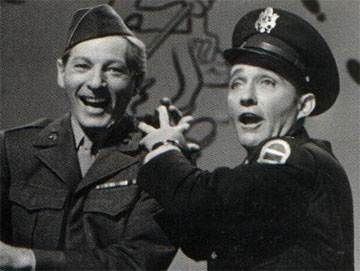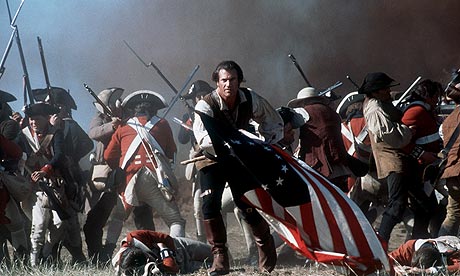'A critical evaluation of the propaganda themes in "White Christmas" (1954)'
| Example of US Propaganda |
The North Atlantic Treaty Organisation (NATO) defines propaganda as “any information, ideas, doctrines or special appeals disseminated to influence the opinion, emotions, attitude or behaviour of any specified group in order to benefit the sponsor, either directly or indirectly.” (Cited in Taylor, 1999) When discussing propaganda it should be understood that there are two main areas into which it falls. The first is the official propaganda released by governments, such as posters and newsreels. The second is feature films, a common medium which was used before and during World War II and has been used in every conflict since. The latter type of propaganda will be the focus of this essay.
During the Second World War time-period the film industry was highly censored. The main source of entertainment, for most, was the feature film. Films were, largely, quite explicitly layered with propaganda. “Joseph Goebbel's view that propaganda is best communicated through entertainment was put into practice by every nation's film industry.” (Sklar, 1993, p.260) These films aimed to influence and teach audiences about the dangers of the war and warn them of the enemy. The Germans were the masters at this technique. They painted the British, and their allies, as demon-like and soulless in brutal ways.
 |
| Still from 'White Christmas' (1954) |
Propaganda films continued to be released worldwide, even after the war efforts were over. The late 1940s and 50s were still a very tense time politically so propaganda was used to remind people that the dangers were ongoing. In Hollywood films, propaganda continued to reaffirm the Americans' beliefs of freedom and national unity. Many of these films portrayed the Army in a glamorous way or aimed to gain sympathy for those soldiers who were still protecting their country.
Firstly, the overall plot has distinct aspects of propaganda through it. The story depicts two ex-soldiers, who are bound together after one saves the other's life. The film opens on Christmas Eve 1944, and then moves to years later when the two men are still friends and successful business partners. Bing Crosby's character continues to feel a great debt to Danny Kaye's character for saving his life. The pair follow a sister duo to Vermont where the girls expect to perform for the holiday season. The men discover that their old Army General has bought the Inn, which is failing. They rally around him and contact their ex-comrades to help them save the 'old man's' livelihood. There are two phrases used repeatedly throughout the film: “Everyone's got an angle” which Bing Crosby's character, Bob, introduces. He feels everyone has an ulterior motive in everything. He accepts that it's part of life. The second is “Let's just say we're doing it for a pal in the army.” Even ten years after the war these men feel a strong bond to the others they served with in WWII. The film portrays the army as one big happy family, which will always be there for its servicemen and women, no matter what.
The opening sequence is one which sticks in the mind. It depicts Bob singing “White Christmas” in front of a snowy backdrop, performing for the troops. The song “White Christmas” became extremely popular during the Second World War. It made soldiers, and those back home, realise what servicemen and women were missing out on while protecting their nation. By the end of the war “White Christmas” was the best selling record of all time. (HymnsandCarols) It was firstly written to appear in another of Crosby's film's, “Holiday Inn”; arguably another Hollywood film full of propaganda. Many people see the film “White Christmas” as a remake of “Holiday Inn” which gives more reason to believe that both films share propaganda motifs. While this classic, much loved, song is being sung bombing can be heard in the background. During the song the camera zooms into the dejected faces of the troops, then pans across the group. Presumably they are thinking of home and the audience automatically feels sympathetic towards these young men, and their sacrifices for their country. Added to this, before Crosby starts to sing, the General, in conversation with his successor and the army driver, states, “there are no Christmases in the army.” This would be unimaginable and very un-American. The whole sequence is dramatised to evoke great sympathy and respect for those serving in the Army.
The main aspects of propaganda in “White Christmas” are most evident at the beginning of the film and towards the finale. When the General appears at the top of the stairs, to attend the show, in his full Army uniform, his granddaughter, waiting below, gazes up at him in awe. The expression on her face is that of pride and love; she looks close to tears. Many men watching the film could have felt an emotional response, and perhaps would want the love and respect that was very evident for General Waverley throughout the film. The soldiers from his regiment surprise the General and begin to sing, “We'll follow the Old Man”; the song they sang when he left the Army. This song epitomises the sense of family and camaraderie being portrayed within the army, which is the emphasis of the entire film. All the soldiers stick together. It draws on the commonly used, “we” of propaganda; united “we” will prevail. The song paints the army, once again, in a warm sympathetic light. It is hard to watch this sequence without feeling some kind of emotional response. It is a very emotive piece and those watching it in the 1950s may have been influenced to stand up and take action; perhaps to even enlist in the Army.
Probably the most notable song in “White Christmas” in terms of propaganda is “Gee, I wish I was back in the Army.” The song could almost be used as part of a recruitment video for the army. The film was released at a time when some conflicts had ended and America was about to engage in new ones. Within any film, which sets out to gain the support of people in national, political and military strategies, it is firstly very important to sharpen the audience's views of “nation” and “identity.” (Fox, 2007) White Christmas, the film, would not have had to do much to achieve this, considering the Korean War was ended and the War in Vietnam inevitable, when the film was originally released. (BBC History) The song, and the entire film paint a picture of the Army during the Second World War as a fun, safe and happy haven. Something those, who actually fought in the war, may not have agreed with. The lyrics really do emphasis how great the Army is. You get three meals a day for which you don't have to pay. There are always superiors who will take the fall for your mistakes. For the ladies, there are hundreds of men, all you have to do is take your pick. The phrase “tough civilian life” sums up the whole song. Life really is better in the Army than as your everyday person living in society. Similarly the song, “What do you do with a General?” implies that once a soldier, even a General, leaves the Forces, life will never be the same for them. The song gives the impression that these soldiers are in the Army for life, even after the conflict is over. One theme that runs through the entirety of the film; the “we” of propaganda.
 |
| Still from 'White Christmas' (1954) |
In conclusion, it is clear that propaganda can be found in the most unlikely of places, even in a well-loved Hollywood Musical. “White Christmas” promotes the army as a great institution; at a time when the forces would have been seeking new recruits for up-coming conflicts. The film also tugs on the heart strings, helping to distract the audience from the sense of being influenced. The way in which this Hollywood classic uses propaganda threads in not explicitly obvious but there definitely are themes and motifs which identify the text as propaganda. It is a world away from Hitler's very powerful propaganda but still had the same intentions to influence those watching. It simply went about this in a completely different manner. Propaganda sets out to evoke a response and “White Christmas” certainly can, or could, when it was released, trigger a reaction, whether it be emotional, or to inject a sense of patriotism within the viewer. Taking into account NATO's definition of propaganda it is clear that “White Christmas” falls into this category. Bing Crosby's character declared, “everyone's got an angle” and even this film “has an angle”; to persuade the people of America that the Army is a great service and life is better when serving in the Army. Certainly after watching “White Christmas” it is easy to understand how many Americans, particularly at the time of release, could have walked out of the cinema thinking, “Gee, I wish I was in the Army...”
Sources
- Film. An International History of the Medium by Robert Sklar. 1993, Thames & Hudson Ltd.
- British Propaganda in the Twentieth Century by Philip M. Taylor. 1999, Edinburgh University Press.
- Hollywood Musicals by Ted Sennett. 1981, Narry N. Abrams.
- Film Propaganda on Britain and Nazi Germany; World War II Cinema by Jo Fox. 2007, Berg.






